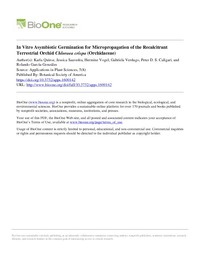In vitro asymbiotic germination for micropropagation of the recalcitrant terrestrial orchid Chloraea crispa (Orchidaceae)
Autor
Saavedra, Jessica
Vogel, Hermine
Verdugo, Gabriela
Caligari, Peter D. S.
García-González, Rolando
Fecha
2017Resumen
Premise of the study: Chloraea crispa is a terrestrial Orchidaceae species native to Chile, characterized by a beautiful and showy inflorescence. The species has a great potential for commercial exploitation in the cut flower industry, but it is essential to improve propagation methods to avoid endangering its natural populations. Because this species is hard to propagate using traditional greenhouse techniques, in vitro techniques offer an effective tool for its large-scale production in terms of germination, growth, and propagation.
Methods: The current study evaluated the effect of the culture medium on the asymbiotic germination of C. crispa seeds, as well as the effects of the plant growth regulators 6-benzylaminopurine and indole-3-butyric acid. Different light regimes were also studied.
Results: A significant effect was observed for the interaction between culture media and light regime on the morphogenic response of the seeds. The highest rate of embryonic germination was obtained in Van Waes medium supplemented with 0.1 mg·L of 6-benzylaminopurine.
Discussion: For the first time, asymbiotic culture of this species using biotechnology tools has been developed. Plantlets developed very well under in vitro conditions, allowing the possibility to propagate and store genetic material for conservation and domestication purposes.
Fuente
Applications in Plant Sciences, 5(8), 1600142Identificador DOI
doi.org/10.3732/apps.1600142Colecciones
La publicación tiene asociados los siguientes ficheros de licencia:



